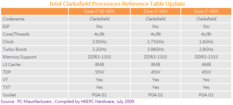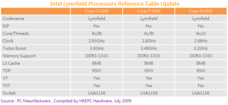Monday, July 6th 2009

Intel Clarksfield Mobile Quad-Core Chips Feature Low TDPs
Using new lows in core clock speeds, Intel is looking to give its upcoming Westmere-based Core i7 "Clarksfield" mobile quad-core processors surprisingly low rated TDPs. Apart from the rest of the known lineup of upcoming Intel processors, it is learned that Intel will initially have three mobile quad-core chips, all branded Core i7, and based on the 32 nm Clarksfield core. The three will include an Extreme Edition (XE) SKU. The clock speeds of these will be surprisingly low: ranged between 1.60 to 2.00 GHz, while having a high Turbo-Boost speed ranged between 2.80 to 3.20 GHz.
The Turbo-Boost speed is enabled when the processor powers-down some of its cores, and increases the clock speed of the cores that are available. In the process, power consumption is reduced. These chips have some very low TDPs that make them ideal for notebooks. The XE variant has a TDP of 55W, while the two lower models have rated TDP of 45W. The low-end model comes with 6 MB of L3 cache, while the higher two have 8 MB. All models have four cores with HyperThreading enabling 8 threads, and lack IGPs. They will run on the new PGA-G1 socket.
In related news, the first three Core i5/i7 "Lynnfield" processors come with rated TDP no higher than 95W. They come with Turbo-Boost Speeds ranging between 3.20 and 3.60 GHz.
Source:
HKEPC
The Turbo-Boost speed is enabled when the processor powers-down some of its cores, and increases the clock speed of the cores that are available. In the process, power consumption is reduced. These chips have some very low TDPs that make them ideal for notebooks. The XE variant has a TDP of 55W, while the two lower models have rated TDP of 45W. The low-end model comes with 6 MB of L3 cache, while the higher two have 8 MB. All models have four cores with HyperThreading enabling 8 threads, and lack IGPs. They will run on the new PGA-G1 socket.
In related news, the first three Core i5/i7 "Lynnfield" processors come with rated TDP no higher than 95W. They come with Turbo-Boost Speeds ranging between 3.20 and 3.60 GHz.


21 Comments on Intel Clarksfield Mobile Quad-Core Chips Feature Low TDPs
Is it a mobile socket?
55 watts tdp for a notebook is a disaster according with fudzilla , 55 watts is ok for a desktp or a server
www.fudzilla.com/content/view/14530/1/
a tdp disaster with fried socket
Getting that down to 55W is hardly magic and not fit for a laptop IMO. Perhaps an mini-ITX transportable system, fine. But a laptop? No.
Intel needs a mobile version of i7, but it needs to target 25W.
If Intel is hitting 45W TDP on their Core 2 mobile processors and they got 45-55W TDP on their i7 based ones, I'd say that's a damn good achievement compared to Core 2 vs i7 desktop chips. Also, considering AMD Turion chips are all around 31W-35W for a dual core Intel is still doing pretty well with a 45W TDP. I haven't seen the TDP on the AMD Tri Cores but it will most likely fall in line around 40 watts. Correct me if that's wrong.
So what makes this way out of line and disastrous? Sure its going to be hot if the Extreme edition CPUs are hitting 55W and the regular mobile chips are hitting 45W, but the performance of Quad i7 vs AMD x3 would warrant the difference. The actual question is if its required in a laptop, or should someone just go buy a desktop.
45W is a great spot for high end passive cooling or relatively low case airflow, so we just need some desktop equivalents for quads in the quiet HTPC market. It will be nice to see more high end laptops offering quads though, the few that exist now are behemoths.
Any laptop with this and a decent GPU will easily be the best out there.
Remember that when comparing Clarksfield to the previous platform, it is meaningless to directly compare the processor TDPs due to the difference in functionality. Unlike the desktop i7, these will be directly attached to the (discrete) graphics card/chip(s) and southbridge, the northbridge, which contained the memory controller and graphics interface, will not be present at all. When the northbridge's power consumption is added to the old proc's, it really isn't much different, if at all.
You guys are out of touch with where this fits in the market. Sometimes fanboys can't get past niche comparisons or even big picture abstractions. Put one of these in a macbook pro with a SSD and DDR3. That will be glorious for video work!